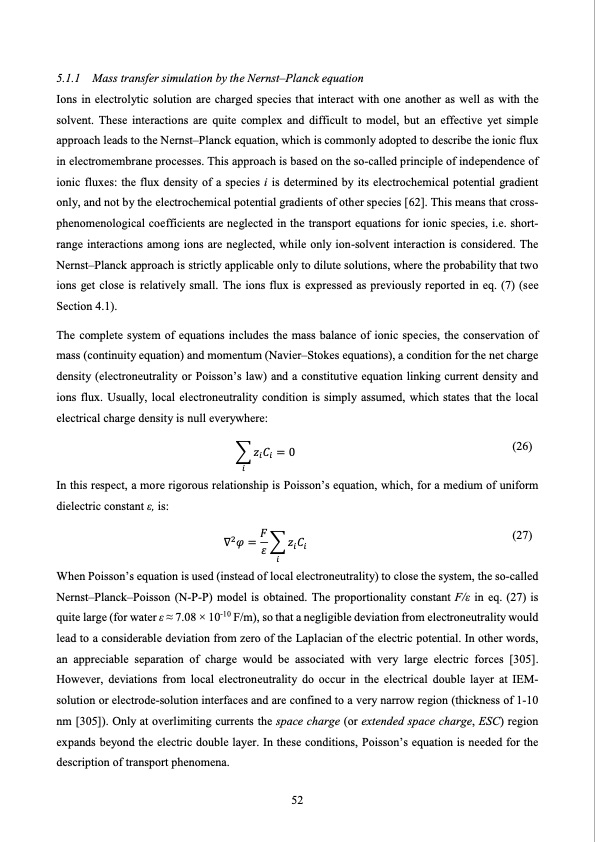
PDF Publication Title:
Text from PDF Page: 052
5.1.1 Mass transfer simulation by the Nernst–Planck equation Ions in electrolytic solution are charged species that interact with one another as well as with the solvent. These interactions are quite complex and difficult to model, but an effective yet simple approach leads to the Nernst–Planck equation, which is commonly adopted to describe the ionic flux in electromembrane processes. This approach is based on the so-called principle of independence of ionic fluxes: the flux density of a species i is determined by its electrochemical potential gradient only, and not by the electrochemical potential gradients of other species [62]. This means that cross- phenomenological coefficients are neglected in the transport equations for ionic species, i.e. short- range interactions among ions are neglected, while only ion-solvent interaction is considered. The Nernst–Planck approach is strictly applicable only to dilute solutions, where the probability that two ions get close is relatively small. The ions flux is expressed as previously reported in eq. (7) (see Section 4.1). The complete system of equations includes the mass balance of ionic species, the conservation of mass (continuity equation) and momentum (Navier–Stokes equations), a condition for the net charge density (electroneutrality or Poisson’s law) and a constitutive equation linking current density and ions flux. Usually, local electroneutrality condition is simply assumed, which states that the local electrical charge density is null everywhere: (26) In this respect, a more rigorous relationship is Poisson’s equation, which, for a medium of uniform dielectric constant ε, is: 𝑧𝐶 =0 ∇ 𝜑 = 𝐹𝜀 𝑧 𝐶 (27) When Poisson’s equation is used (instead of local electroneutrality) to close the system, the so-called Nernst–Planck–Poisson (N-P-P) model is obtained. The proportionality constant F/ε in eq. (27) is quite large (for water ε ≈ 7.08 × 10-10 F/m), so that a negligible deviation from electroneutrality would lead to a considerable deviation from zero of the Laplacian of the electric potential. In other words, an appreciable separation of charge would be associated with very large electric forces [305]. However, deviations from local electroneutrality do occur in the electrical double layer at IEM- solution or electrode-solution interfaces and are confined to a very narrow region (thickness of 1-10 nm [305]). Only at overlimiting currents the space charge (or extended space charge, ESC) region expands beyond the electric double layer. In these conditions, Poisson’s equation is needed for the description of transport phenomena. 52PDF Image | Electrodialysis for water desalination

PDF Search Title:
Electrodialysis for water desalinationOriginal File Name Searched:
Review_ED-self-archived.pdfDIY PDF Search: Google It | Yahoo | Bing
NFT (Non Fungible Token): Buy our tech, design, development or system NFT and become part of our tech NFT network... More Info
IT XR Project Redstone NFT Available for Sale: NFT for high tech turbine design with one part 3D printed counter-rotating energy turbine. Be part of the future with this NFT. Can be bought and sold but only one design NFT exists. Royalties go to the developer (Infinity) to keep enhancing design and applications... More Info
Infinity Turbine IT XR Project Redstone Design: NFT for sale... NFT for high tech turbine design with one part 3D printed counter-rotating energy turbine. Includes all rights to this turbine design, including license for Fluid Handling Block I and II for the turbine assembly and housing. The NFT includes the blueprints (cad/cam), revenue streams, and all future development of the IT XR Project Redstone... More Info
Infinity Turbine ROT Radial Outflow Turbine 24 Design and Worldwide Rights: NFT for sale... NFT for the ROT 24 energy turbine. Be part of the future with this NFT. This design can be bought and sold but only one design NFT exists. You may manufacture the unit, or get the revenues from its sale from Infinity Turbine. Royalties go to the developer (Infinity) to keep enhancing design and applications... More Info
Infinity Supercritical CO2 10 Liter Extractor Design and Worldwide Rights: The Infinity Supercritical 10L CO2 extractor is for botanical oil extraction, which is rich in terpenes and can produce shelf ready full spectrum oil. With over 5 years of development, this industry leader mature extractor machine has been sold since 2015 and is part of many profitable businesses. The process can also be used for electrowinning, e-waste recycling, and lithium battery recycling, gold mining electronic wastes, precious metals. CO2 can also be used in a reverse fuel cell with nafion to make a gas-to-liquids fuel, such as methanol, ethanol and butanol or ethylene. Supercritical CO2 has also been used for treating nafion to make it more effective catalyst. This NFT is for the purchase of worldwide rights which includes the design. More Info
NFT (Non Fungible Token): Buy our tech, design, development or system NFT and become part of our tech NFT network... More Info
Infinity Turbine Products: Special for this month, any plans are $10,000 for complete Cad/Cam blueprints. License is for one build. Try before you buy a production license. May pay by Bitcoin or other Crypto. Products Page... More Info
| CONTACT TEL: 608-238-6001 Email: greg@infinityturbine.com | RSS | AMP |